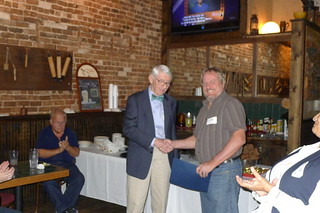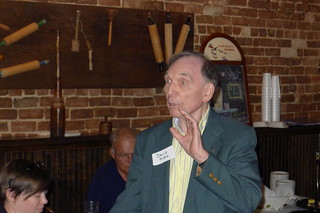Last night Laura and I attended the fall awards dinner for the Western Carolinas chapter of the American Chemical Society. The event was held at Hannah Flannagan’s in Hendersonville. Recognition was given to those who had been members of ACS for 50 and 60 years. Carl Kort, interim president of Furman University addressed the group.
I admit to being a science geek, but the depth of my knowledge is limited to general topics. Most of the ACS topics are far over my head. However, this one was targeted toward the general public, and it turned out to be a fascinating evening.
As we were driving up, Laura casually mentioned that I had been designated event photographer. Oops. Fortunately, I had my little Panasonic camera, as I always do, so things were OK.
There was general mixing and mingling, then things started to settle down for dinner. Since I had to take photos we got a table right at the front with several of our friends. Seated directly across from me was none other than Carl Kort.
As a Furman chemistry grad from the 1970s, Carl has had a long association with the department. We have met on several occasions, and he has long been a contributor to the department. The main atrium of the new science building even bears his name – the Kort Commons.
We had a great discussion. For most of his career, Carl was vice president of research and development at Eastman Kodak. That connection to photography made it easy for me to participate in the conversation. Through the course of the discussion I learned that Carl basically invented dye sublimation printing as a method of retrieving images from satellites. He said that high resolution images from satellites were actually dropped via parachute and retrieved by C130 cargo planes. He was tasked with creating a method whereby the images could develop in route, and dye sub was the solution. This worked well, until one of his co-workers had another idea..
Carl’s good friend and co-worker at Kodak was Steven Sasson, who is credited as the inventor of the digital camera. Carl said that he has in his possession the 2nd digital camera ever built, and that in 2011 he was invited to a White House gathering honoring Sasson.
Most of the Furman faculty have been impressed with Carl during his tenure as interim. Many wish that he would just make the job permanent. However, he has only agree to serve until the search process is completed. Over dinner he said that he he experience more trepidation about taking the Furman presidency than any other position. With the other jobs, if he screwed up, all they could do was fire him. However, with Furman he had too much emotional connection, and wanted to make sure he did the best possible job for the university.
I came away from the dinner with an appreciation for Carl’s brilliance and down-to-earth personality. During his talk, he elaborated on his career. He said that he had gone to the Kodak leadership and said that they should capitalize on their monopoly of digital technology. However, the company chose to stay with its chemical-based photo processing. It was at that time that Carl decided to leave, and the rest, as far as Kodak is concerned, is history. He later worked with several other start-ups until eventually taking his current position.
As impressive as Carl Kort’s talk was, the honorees were equally impressive. Elaine Marten had also worked at Kodak. Several others had patents and inventions to their name. It was interesting to hear them speak of their long careers and accomplishments. Tim Hanks handed out the awards after each spoke.
It was a great evening of science with friends. I was happy to be a part of it.







